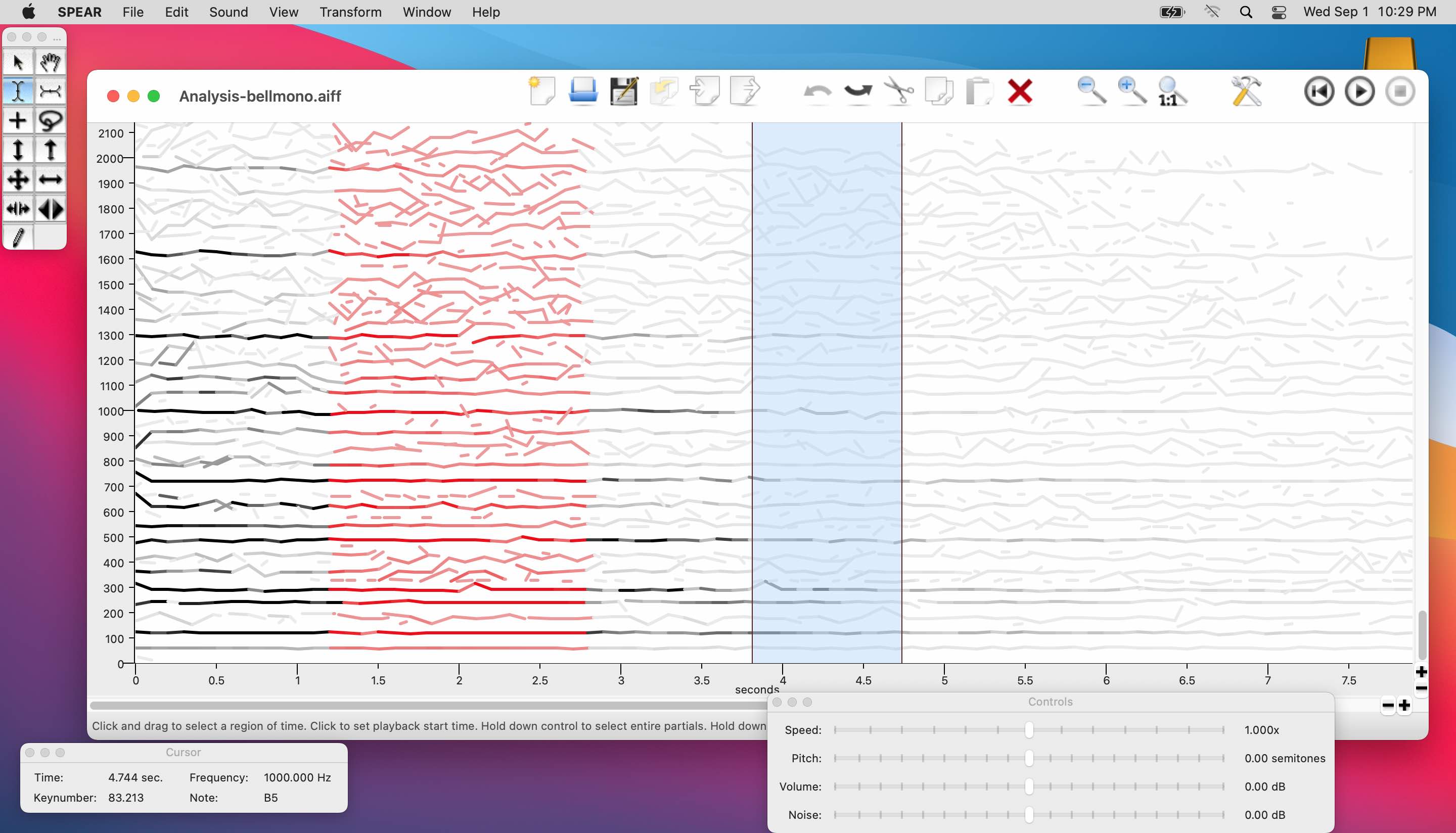S P E A R
Sinusoidal Partial Editing Analysis and Resynthesis
for macOS, MacOS 9 and Windows
News
Sept. 6, 2021 Version 0.8.2 should reduce high idle CPU consumption. Click here to download This version is a 64-bit application for Intel or Apple silicon and macOS 10.10 or newer. Note that this build is self-signed. You will likely see a warning “SPEAR” can’t be opened because Apple cannot check it for malicious software. Right click on SPEAR, and choose Open. Then click the Open button.
Sept. 4, 2021 Initial support for macOS 11 Big Sur and Apple silicon. Version 0.8.1 has been released. Click here to download This version is a 64-bit application for Intel or Apple silicon and macOS 10.10 or newer.

Sept. 22, 2018 SPEAR is still alive! Version 0.8.0 for macOS has been released. Click here to download This version is a 64-bit application for macOS 10.10 or newer.
Nov. 29, 2009 Version 0.7.4 has been released. Click here to download for Windows XP/Vista and MacOS X (10.4 or later). This version fixes a bug with SNDAN files.
What's new in this version?
- Support for Unicode filenames/pathnames. This fixes the long standing problem with pathnames containing non-ASCII characters.
- Reorganized and streamlined synthesis options in the Sound menu. Choose various options under the "Synthesis Method" submenu.
- Reorganized synthesis preferences.
- Preferences for controlling noise resynthesis. The noise bandwidth and filter order can be adjusted. High filter orders will produce a noise band with a steeper amplitude cutoff slope.
- Adjustments to the scaling effect of the noise slider.
- Windows bug fixes.
Known Problems
- No manual.
Problems? Questions?
Jun. 24, 2008 Version 0.7.1 released for MacOS X and Windows XP/Vista. Features include: pencil tool for drawing new partials, fade in/out selected partials, support for DirectSound and ASIO sound devices on Windows (select in the Preferences window), no expiration date.
Jun. 24, 2007 Version 0.7.0 is released as a Universal Binary for MacOS X 10.4. Finally!! New features are minimal, but include a fade-in/out option and a nice new set of toolbar icons. New Windows versions will be made available in the near future. Note: this version requires MacOS X 10.4 or later and will not run on 10.3. For those needing 10.2 or 10.3 compatibility, look to version 0.6.4r2 which is identical to 0.6.4 but includes the new icons. Visit downloads for all the details.
Dec. 14, 2006 Version 0.6.4 released for MacOS and Windows. Due to the beta expiration date in version 0.6.3, version 0.6.4 is now available. Sadly there are no new features. The Universal Binary version is still in the works. Visit downloads.
Feb. 15, 2006 Version 0.6.3 released. This is the last release for MacOS 9. Visit downloads.
- RBEP export
- using v19 (development version) of PortAudio. This may solve compatibility problems with some audio interfaces.
- using v1.0.13 of Erik de Castro Lopo's libsndfile. Supports reading Sound Designer II files (at least on MacOS X)
- analysis frequency tracking bug fixed
Help page available.
Introduction
SPEAR is an application for audio analysis, editing and synthesis. The analysis procedure (which is based on the traditional McAulay-Quatieri technique) attempts to represent a sound with many individual sinusoidal tracks (partials), each corresponding to a single sinusoidal wave with time varying frequency and amplitude.
Something which closely resembles the original input sound (a resynthesis) can be generated by computing and adding all of the individual time varying sinusoidal waves together. In almost all cases the resynthesis will not be exactly identical to the original sound (although it is possible to get very close).
Aside from offering a very detailed analysis of the time varying frequency content of a sound, a sinusoidal model offers a great deal of flexibility for editing and manipulation. SPEAR supports flexible selection and immediate manipulation of analysis data, cut and paste, and unlimited undo/redo. Hundreds of simultaneous partials can be synthesized in real-time and documents may contain thousands of individual partials dispersed in time. SPEAR also supports a variety of standard file formats for the import and export of analysis data.
Read more in the ICMC paper “Software for Spectral Analysis, Editing, and Synthesis.” (pdf) or in the dissertation paper Spectral Analysis, Editing, and Resynthesis: Methods and Applications.
Current Status
Currently SPEAR runs on macOS, MacOS 9 and Windows. For a variety of reasons SPEAR will probably operate better on macOS. The program is still in a pre-1.0 stage, meaning that not only will there be some bugs but that significant underlying changes may still take place before a 1.0 release. With that said, it is currently quite stable and useful.
Feeback
Please address feedback to:
Downloads
Please visit the download page.
Future Development
The program has been written with portability in mind (using the wxWidgets framework) so future versions could run on GTK. There are of course numerous features I would like to add.